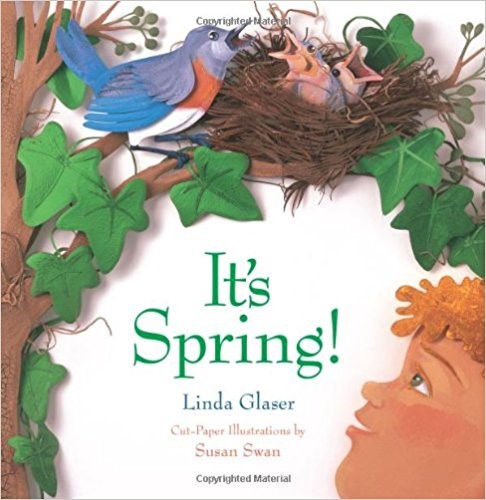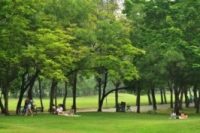Option 1: Use the Key Vocabulary: Level B student page to introduce or reinforce key terms used in this level. Refer to the Key Vocabulary: Level B teacher page for the correct responses.
Option 2: Deepen students’ learning beyond the classroom by sending them home with one of the Home Connections student pages to do with their family (see Home Connections below). Encourage students to share their home experiences with the class.
Option 3: Conduct an investigation on whether plants grow more with or without sunlight. Using plants of the same size and type, give half of the plants full access to sunlight (by placing them in a sunny window or outside) and half no access to sunlight (by placing them in a dark cupboard or closet). Make sure all plants have the same water, soil, and space. At set intervals, have students measure the plants to compare their growth.
Option 4: Read aloud Underneath My Favorite Tree by M.L. Green (see Literature Connections below), and then invite students to create poems describing what they like about their adopted tree.
Option 5: After reading My Favorite Tree: Terrific Trees of North America by Diane Iverson (see Literature Connections below), exchange pictures of the class’s adopted tree throughout the year with a class in another region to see how trees may differ in different places.
Option 6: Read A Tree Is a Plant by Clyde Robert Bulla (see Literature Connections below), and then grow an avocado tree from seed. Direct students to observe the tree over time as it grows.
Option 7: After reading A Tree for All Seasons by Robin Bernard (see Literature Connections below), take periodic pictures of the same tree limb over the course of the year to see how it changes and how it stays the same.
Home Connections
Parents and families play an important role in supporting science learning. Home Connections offer suggestions for activities to do at home that build on students’ in-class learning.
Literature Connections
Pairing classroom instruction with fiction and nonfiction resources supports content comprehension, expands student creativity, and provides real-word context. These Literature Connections enhance the concepts explored in the Treemendous Science! activities.
| Activity | ||
|---|---|---|
| Engage: Growing Up Green |  |
Bulla, Clyde Robert. A Tree is a Plant. HarperCollins. 2002. This colorfully illustrated book guides students though the life cycle and growth of an apple tree in a step-by-step approach. Grades PreK–2. ISBN: 978-0439456142. |
| Engage: Growing Up Green |  |
Gibbons, Gail. From Seed to Plant. Holiday House. 1991. The mystery of how seeds are formed, travel, and grow into plants is revealed for young readers in this informative nonfiction book. Grades K–3. ISBN: 978-0823410255. |
| Engage: Growing Up Green |  |
Sayre, April Pulley. Trout Are Made of Trees. Charlesbridge. 2008. Try using this book to teach children about life cycles and the greater interconnectedness of nature. Grades K–2. ISBN: 978-1580891387. |
| 1: Adopt a Tree |  |
Green, M.L. Underneath My Favorite Tree. PublishAmerica. 2008. Read along with this playful poem as Nadieya imagines all of her favorite things she would see underneath her beloved tree. Grades K–2. ISBN: 978-1604748581. |
| 1: Adopt a Tree |  |
Hall, Kirsten. The Gold Leaf. Enchanted Lion Books. 2017. In the spring, among many shades of green, there is one gold leaf. Following the serial theft of this leaf, you will find nature’s wisdom. Grade PreK–3. ISBN: 978-1592702145. |
| 1: Adopt a Tree |  |
Iverson, Diane. My Favorite Tree: Terrific Trees of North America. Dawn Publications. 1999. Explore 27 of the major native North American trees, along with the food, shelter, and their importance to our heritage. Grades K–3. ISBN: 978-1883220938. |
| 1: Adopt a Tree |  |
Locker, Thomas. Sky Tree: Seeing Science through Art. HarperCollins. 2001. Travel through the seasons and learn about the passage of time in nature in this beautifully illustrated book. Grades K–4. ISBN: 978-0064437509. |
| 1: Adopt a Tree |  |
Muth, Jon J. Hi, Koo!: A Year of Seasons. Scholastic Press. 2014. Join a bear named Koo and two human siblings as they challenge readers to stretch their minds with 26 haikus about the four seasons. Readers of all ages can enjoy not only the fun and frivolous haikus, but also the changing color palette of Muth’s watercolor art as it follows the seasonal transformations. Grades PreK–3. ISBN: 978-0545166683. |
| 1: Adopt a Tree |  |
Stewart, Melissa. Under the Snow. Peachtree. 2009. Learn how snakes, salamanders, carp, beavers, and other animals spend their days during the winter months. Grades K–2. ISBN: 978-1561454938. |
| 1: Adopt a Tree |  |
Udry, Janice May. A Tree is Nice. HarperCollins. 1987. This classic Caldecott Award–winning book teaches of the beauty of the everyday world and the many pleasures a tree provides. Grades K–3. ISBN: 978-0060261559. |
| 2: Signs of Fall |  |
Ehlert, Lois. Leaf Man. Harcourt. 2005. Fall has come, the wind is gusting, and Leaf Man is on the move. No one’s quite sure where he is going, but this much is certain: A Leaf Man’s got to go where the wind blows. Grades PreK–3. ISBN: 978-0152053048. |
| 2: Signs of Fall |  |
Florian, Douglas. Autumnblings. Greenwillow Books. 2003. This children’s book explores the colors, events, and emotions that the fall season brings, and it serves as a special treat for those of us who are not fortunate enough to witness the most dramatic effects of the changing seasons. Grades 1–5. ISBN: 978-0060092788. |
| 2: Signs of Fall |  |
Hawk, Fran. Count Down to Fall. Sylvan Dell Publishing. 2009. Reinforce counting and basic numeric expressions with a variety of trees and woodland animals as autumn changes take place. Grades K–2. ISBN: 978-1607180593.
|
| 2: Signs of Fall |  |
Sherrow, Victoria. Chipmunk at Hollow Tree Lane. Soundprints. 1994. As winter nears, students follow a little chipmunk trying to gather enough food for the long hibernation. Grades PreK–3. ISBN: 978-1607276357. |
| 3: Every Tree for Itself |  |
Ehlert, Lois. Red Leaf, Yellow Leaf. HMH Books for Young Readers. 1991. This book examines the life of a sugar maple tree growing in the yard of a young child, who narrates the story. Grades PreK–3. ISBN: 978-0152661977. |
| 3: Every Tree for Itself |  |
Kudlinski, Kathleen. How Plants Survive. Newbridge Educational Publishing. 2002. A plant’s life is not as easy as you might think. Plants compete with one another for sunshine, wage battles for water, and struggle to protect their own patch of soil. Their lives are a constant battle for survival. Grades 1–3. ISBN: 978-1582737089. |
| 4: Bursting Buds |  |
Bernard, Robin. A Tree for All Seasons. National Geographic Society. 2001. This picture book records the growth of a maple tree over a period of time to illustrate what trees do and how the seasons change. Grades PreK–3. ISBN: 978-0792266747. |
| 4: Bursting Buds |  |
Glaser, Linda. It’s Spring!. National Geographic Society. 2010. Simple text and bold paper sculpture convey the animal life, plant life, weather, and clothing, as well as the colors and feelings, associated with the spring season. Grades PreK–2. ISBN: 978-0761313458. |








